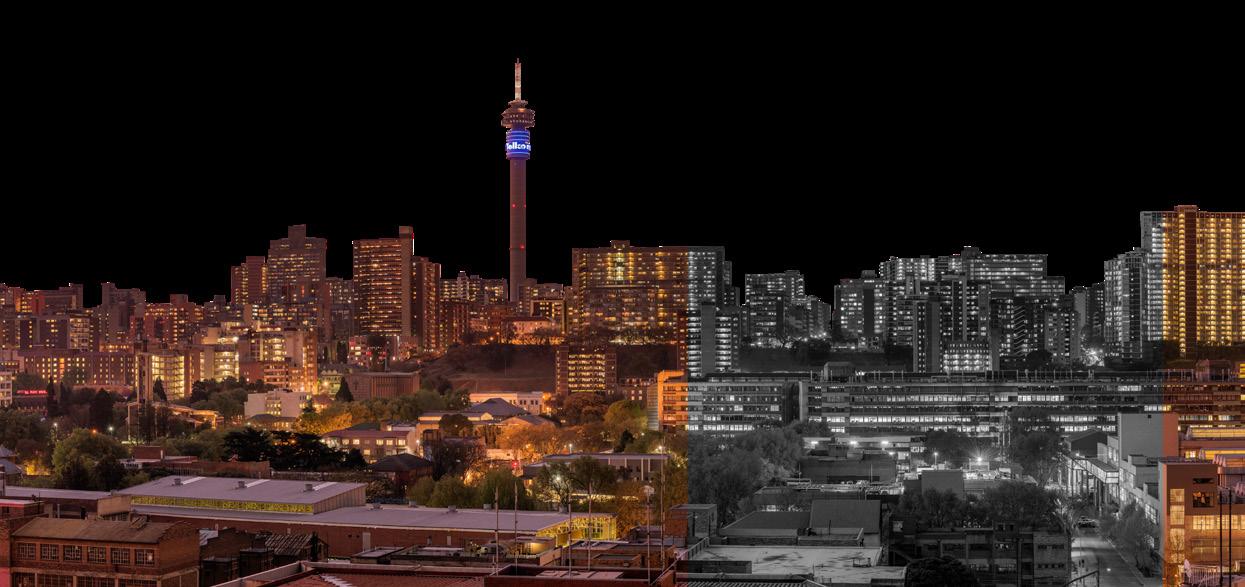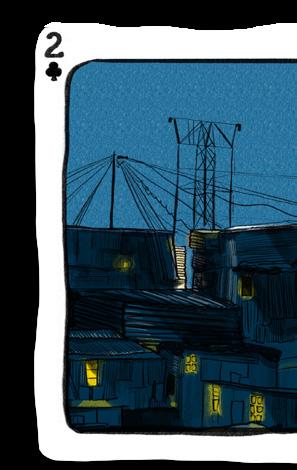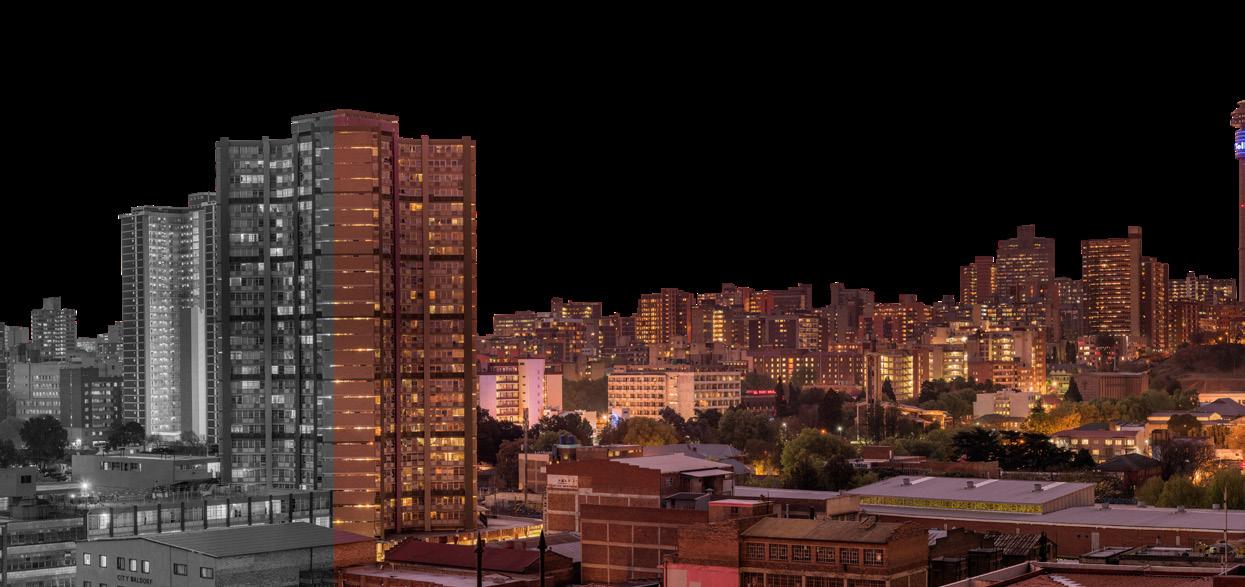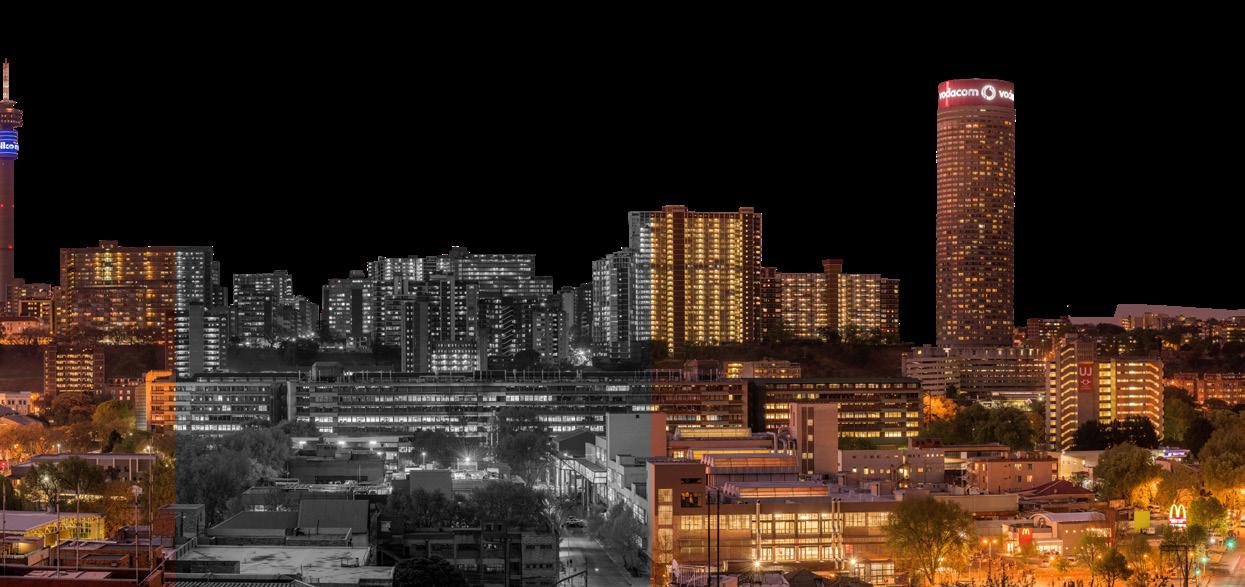
10 minute read
ROLLING BLACKOUTS: LIGHT AT THE END OF THE TUNNEL?
from Curiosity Issue 15
by Curiosity
South Africa’s next move in the power generation rigmarole could create a new model for many countries facing power shortages. But it could also lead to more muddling in the dark, writes Ufrieda

Ho.

South Africans by now all know that the state power utility, Eskom, is in a dizzying death spiral and that the country looks set for more years of power cuts. But rock bottom is about as good a place as any to start finding a way for SA to crawl out of this mess.
The reality and outrage around Stage 6 rolling blackouts have come with sober reckoning of how South Africa ended up in the deadening abyss of a power crisis, now veering towards collapse.

Reckoning continues after a summer of the worst loadshedding in the country to date, and as more of the web of state capture – as set out in the Zondo Commission’s report – reveals the extent of corruption, looting, and sabotage at the state-owned power utility.

POWER IN THE ‘90S
There have also been years of systematic stripping of technical and management capacity, while none of the appropriate skills transfer and development necessary for continuity and growth at the utility was done.
Analysts have tracked this slide at Eskom as far back as Thabo Mbeki’s presidency in the late 1990s. The ANC’s priority of politicking, rather than governing competently, compromised the development and strategic investment needed to ensure a robust and durable energy generation plan.
The bleak picture of Eskom’s slide to rot leaves the country’s ‘what next?’ in terms of power supply looking like more of the same loadshedding nightmare, and with it the devastating impacts on the economy and people’s day to day lives. At some point, a plan of action needs to kick in.
STATE OF EMERGENCY, INCENTIVES, PENALTIES
That ‘some point’, says Professor Rod Crompton, should have arrived by 2022 already. Crompton, who is Visiting Adjunct
Professor in the Wits Business School’s African Energy Leadership Centre and a long-serving non-executive member of the Eskom board, says declaring a state of emergency is a first step.
“It’s a short-term measure of an ‘all hands on deck’ approach in which all citizens are involved in dealing with the electricity crisis,” says Crompton.
He says thousands of small solar power stations – from those in private homes and small businesses, to commercial and industrial enterprises – should be supplying surplus power to the grid to lessen the burden of loadshedding. “This can be further ramped up through tax incentives and reviving electricity substitution initiatives that have gone quiet,” he says.
One such initiative is the liquid petroleum gas (LPG) programme, which the Department of Mineral Resources and Energy (DMRE) announced in April 2021.
The programme was meant to transform the sector to allow for more small, black-owned enterprises to enter the LPG supply chain, and looked to target increased household LPG use for cooking and heating.
“A rapid introduction of tax incentives and VAT exemptions for all kinds of power-generating equipment, from tiny to industrial scale, would be a big help. The DMRE’s initiatives could have also seen VAT exemptions on gas cookers and cylinders,” says Crompton.
Another measure is for decisive action to be taken against electricity theft and non-payment of services. Things such as tipoff hotlines, reward schemes, and swift convictions and penalties for perpetrators could help.
SHEDDING LIGHT LONG-TERM

The longer ter m strategy to claw out of the electricity pit, however, requires a different kind of action. Crompton explains that while Eskom has a so-called ‘nine-point plan’ targeted at its generation facilities, its maintenance budget and technical and management competences are depleted.
“Some parts have to be ordered two years in advance of a planned maintenance shutdown, which requires detailed mechanical and financial planning – all difficult to do as unplanned maintenance has to be carried out as breakdowns happen,” he says.
Ultimately, state control and ownership at all levels of government must be removed from power infrastructure. However, this is easier said than done given the broken body politic in South Africa.
“The more government gets out of the way and allows the market to operate, the sooner we will see an end to loadshedding and a return to reliable supply,” says Crompton. “However, markets require rules and policing too, and the skills in government to draft such rules are few and far between. There’s also political antagonism from some quarters towards such a dispensation. The fact is skills exist outside of government and there are many willing to help. If only government would accept the help that it needs.”
The wake-up calls from the loadshedding crisis of this summer are as follows:
• Remove political interference

• Remove state control of strategic infrastructure
• End reliance on large, centralised power generation
• Invest in appropriate technologies sooner
• Skills development and deployment of the right people to do the job
• Shore-up accountability, transparency, and clearer communication to the public.
New Designs On Power
Eskom, which Crompton say is in “a death spiral”, can’t recover because it’s now an expensive relic. It is still in the process of being unbundled into three separate entities, which has been on the cards for years. In 2017, the Organisation Undoing Tax Abuse (OUTA) laid a complaint with the Competition Commission challenging Eskom’s monopoly in the electricity market and called for a separation of Eskom’s management and control of the grid from its generating activities.


Professor Imraan Valodia, Pro Vice-Chancellor: Climate, Sustainability and Inequality, says South Africa must look to creating a flexible model for power generation. “We no longer need a big monopoly for power generation like Eskom. The technology and price of renewables are dropping fast; there are also all sorts of new entrants into the markets, but we have to open up the system so they can be part of the model,” he says.
‘ELECTRICOMPLEXITY’ – WHO GAINS, WHO LOSES?
Valodia believes there needs to be a different design of state regulation and control. “The power distribution system is not something that you want in private sector hands, because you want the state to make sure that the grid is producing and pushing electricity to those who need it, so that should be owned by the public. But it needs to be a model that allows for different types of power generation to become part of the energy mix easily.”
He adds that there’s also a need for the rapid scaling up of renewable energies; advancing research and development into overcoming existing challenges like ensuring reliable, long-term storage of energy from renewables; decentralising power generation; and improving integration of systems. This, crucially, has to extend to reckoning with the fuller impact of how generation and consumption of energy impacts the environment and the most vulnerable in society. Control and access to electricity and energy still comes down to the divides between the haves and the have-nots, locally and globally, says Valodia.
“In South Africa we have had very cheap energy for years, but it is because we have never counted the cost to the environment, to emissions and global warming, and to people’s health,” says Valodia. “There’s also the ongoing debate between the Global North and the Global South of why countries in the north, which are the world’s biggest polluters, don’t want countries in Africa to invest in fossil fuel industries, even though they have happily been using oil and gas for generations,” he says, emphasising the complexity of the story of electricity – which is also about who stands to gain and who are the losers.
Opportunities In Crises
For Willie Cronje, Professor in the School of Electrical and Information Engineering, there are opportunities that will come from walking away from Eskom. “As it is, Eskom will never be able to catch up on the political folly that led to lost decades of missed maintenance and strategic investment,” he says. “Eskom ran up a deficit over the years and now too much damage has been done. But this crisis creates new demands and new opportunities, for those who are providing solar power panels or inverters, for instance, so this is a new growth industry.”
Cronje’s research focuses on smarter micro-grids. These are what he calls ‘stackable systems’ that start with individual rooftop solar, connect to become neighbourhood systems and then become city-wide grids. They’re small but flexible.

He echoes Crompton’s and Valodia’s sentiments that the time of centralised power is over. “Mega level energy generation means things can become mega mess-ups,” he says. Cronje points out that South Africa’s loadshedding – ostensibly a way to manage electricity distribution to avert a total power breakdown in the country – has made the country a high profile “case to watch”. Many other countries also face looming energy crises, exacerbated by the knock-on effects of Russia’s invasion of Ukraine a year ago.
“Worldwide, electricity infrastructure has been ageing, so the shortages of energy are being felt across the globe. So, in a strange way, South Africa is ahead of the curve, and we are starting to see people coming to South Africa to see how we deal with this crisis,” says Cronje.
It’s another reason why our ‘what next?’ must be light at the end of the tunnel and not more muddling in the dark. C

HOW DO WE SPEND $8.5BN CORRECTLY TO ENERGISE AND GREEN SA?

Andrew Lawrence in the
School of Governance explores how funding received from the Just Energy Transition Partnership can most benefit

The Just Energy Transition Partnership (JETP)’s $8.5 billion (R152 billion) sounds like a lot, but it’s a fraction of what is needed to get South Africa firmly on the path to a more sustainable energy and climateresilient system. To meet its Nationally Determined Contribution (NDC) alone requires four times this amount per year for the next 15 years.
THE ‘BUILD BACK BETTER’ CONUNDRUM
The best policies lay the groundwork to ‘build back better’ politically (via transparent and participatory implementation), economically (avoiding financial risk and debt), socially (ending energy poverty and social marginalisation), and ecologically (reducing emissions and other harmful impacts). These are not inevitable trade-offs, but rather different facets of the same sustainability strategy that can maximise decent job growth. When trust in government is at an all-time low, the political facet becomes all the more important.
Current plans address some of these goals better than others. Rapid decommission of aging, malfunctioning coal generation infrastructure now enjoys broad consensus. This is (hard-earned) progress; as recently as 2020, some were still arguing that –unlike coal, supposedly – wind and solar “cannot be relied on to produce electricity whenever it is needed” (ignoring the question of storage, about which, more below).
Since then, the price the country has paid for not transitioning to renewable sources sooner and more decisively has been more than 2 000 hours of loadshedding, costing the economy hundreds of billions of Rands. Both as a means of generation, and as a nexus of unaccountable corruption, coal can no longer ‘be relied on’ by South Africans needing secure and affordable electricity.
Refitting Tariffs And Infrastructure
Most of the JETP spending ($7.6 billion) is for electricity infrastructure, which might make sense, but how it is built and who will finance and own it remain open questions.
The Zuma government’s decision to jettison its proposed Renewable Energy Feed-in Tariff (REFIT), which placed an obligation on Eskom to purchase the output from qualifying renewable energy generators at pre-determined prices, was opaque and never convincingly argued. Had the REFIT remained, it may well have more than paid for itself in terms of avoided loadshedding, cheaper electricity, and increased capacity, compared to the actual Renewable Independent Power Producer Programme (REIPPP) implementation.
Diversify To Empower People
Twenty-nine municipal Feed-in Tariffs, though modest, show what’s already possible. More ambitiously, progressive tariffs could promote cooperative, municipal- or communityowned infrastructure, thereby providing a major incentive to maximise small-scale generation and so also renewable energy employment, while helping to strengthen the grid. Until trust in national government is restored, however, this may be possible only at the provincial level.
Progressive tariffs could also help to finally achieve 100% electricity access for rural areas and informal settlements; targeting these and other low-income households generally achieves the biggest welfare gains, with each Rand spent on a distributed energy subsidy yielding more than a Rand in economic benefit. Diversifying sources also helps reduce retail electricity prices, provided policies are designed transparently with meaningful public input.
Promote Biogas
Budgeting $700m for ‘green’ hydrogen is more debatable. Sceptics rightly question how ‘green’ this hydrogen ends up being, since the temptation and practice is to blend it with fossil-fuel derived sources. Supporters tout its capacity to “decarbonise highly polluting and hard-to-abate sectors, such as cement, steel, and glass”.
But a closer look at the actual deals signed at COP27 shows that the overwhelming focus is on mining: Anglo’s H2 Valley/ Mining Trucks, and to a lesser extent, an ArcelorMittal direct reduced iron (DRI) plant. Most of this output will likely be for exported rather than for local use, and mostly of ore (including coal) rather than higher value-added manufacturing.
Rather than hydrogen, or (even worse) off-shore gas drilling, which endangers coastal economies and ecologies, better options include gravity-based storage, as well as promoting SA’s nascent biogas industry, with a 2.5 gigawatt potential capacity that would be cost-competitive with true green hydrogen, create thousands of jobs, reduce fertiliser needs, waste removal and landfill costs, and provide a more secure source of methane for peaking plants.
ELECTRIFY SA’S MINIBUS TAXIS
Regarding the $200m for electric vehicles (EVs), much of the potential benefit depends on how this is spent. Apart from in-sourcing as much of the EV value chain as possible, there are opportunities for improving the local transport landscape, while using EVs as another grid storage solution.
Electrification of SA’s minibus taxi fleet (the mode of transport for two thirds of SA households) together with vehicle-to-grid (V2G) infrastructure, costing about this amount, would achieve these goals by providing more than five gigawatt hours of storage capacity, almost twice the current capacity of all of South Africa’s pumped storage (which should also be expanded). The older replaced taxis could be used for under-served rural areas.
Green Credit Policies For Big Dollar Debts
Critics of the JETP observe correctly that most of the funding ($5.3 billion) is in dollar-denominated loans with increasingly steep interest rates, not grants. Since the Rand predictably depreciates against the dollar, such loans end up costing much more.
South Africa already has the eighth highest balance sheet exposure to the dollar (due to its reserves to short-term external debt ratio, and to relatively large foreign holdings of local debt) – this is a major concern. Far better would be to adopt allocative green credit policies (including reserve requirement adjustments, Special Drawing Rights, and allocative credit policies) that leverage local financial market actors to pursue more ambitious goals, like ‘in-sourcing’ the whole value chain of major renewable energy components – photo voltaic manufacture, wind turbines, and batteries – for more sustained employment and export growth. C
Dr Andrew Lawrence is a Visiting Research Scholar in the Wits School of Governance. He has written extensively on energy and climate politics, comparative and global political economy, and worker and employer collective action, with recent articles in Competition and Change, Renewable and Sustainable Energy Reviews, and Review of International Political Economy. His books include South Africa's Energy Transition (Palgrave, 2020) and Employer and Worker Collective Action (Cambridge University Press, 2014).










